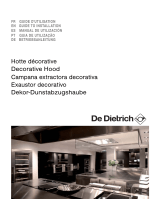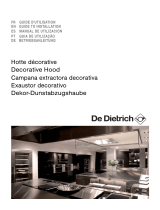
User's guide - Trapezoid hood
GB

Introduction
Dear Customer,
Thank you for choosing the De Dietrich hood.
Our design staff have produced a new generation of kitchen
equipment, to make everyday cooking a pleasure.
The modern, attractive design of your new De Dietrich hood
will blend smoothly into your kitchen installation, providing
an optimum combination of easy use and performance.
The De Dietrich range also includes a huge choice of fitted
cooking hobs, ovens, dish-washers and refrigerators, that
will match your new De Dietrich hood.
A specialist in the world of cooking,
De Dietrich works
hard to contribute to your culinary success, and your cooking
pleasure, offering ever more effective products, which are
easy to use, environmentally friendly, attractive and reliable.
The De Dietrich name.
99635681-A .qxd 07/01/05 9:30 Page 2

Safety instructions
- You should never "flambé" dishes under the hood or operate gas rings under the
hood without cooking utensils being placed on them (the flames sucked up into the
hood can damage the appliance).
- When frying food under the appliance, a careful watch must be kept on this at all times.
- Repairs must only be carried out by an approved specialist.
- You should regularly clean the filter cartridge to avoid any risk of fire.
- The hood should never be used over a combustible fuel burning stove (wood, coal, etc).
These hoods have been designed for non-commercial use in private homes.
With a view to constantly improving our products, we reserve the right to modify their
technical, functional or aesthetic characteristics, making any changes to their features
considered necessary or desirable in view of technical progress.
These hoods are designed exclusively for cooking foodstuffs and drinks. These products do not
contain any asbestos based components.
Throughout this manual,
indicates safety recommendations,
indicates advice to help you make the
best use of your oven
99635681-A .qxd 07/01/05 9:30 Page 2

The controls on your hood Fig.1
In the case of a kitchen heated by a device connected to a chimney (for
example a stove) the "recycling" version of the hood should be installed. Do
not use the hood without metal filters.
Suitable ventilation should be ensured for the room when the suction hood is
used at the same time as appliances using gas or another combustible fuel.
3-speed model
Motor off
Slow speed
Medium speed
Fast speed
Light off
Light on
Installing your hood?
If you possess an outlet to the exterior: fig. 4
Your hood can be connected to this using a flue (Ø 150 mm, enamelled, made from
aluminium, flexible or made from a non-flammable material).
If y
ou do not possess an outlet to the exterior: fig. 5
All of our appliances can be used in recycling mode.
In this case, you should add an active carbon filter which will keep in odours.
99635681-A .qxd 07/01/05 9:30 Page 2

The hood must be installed in conformity with the applicable regulations
concerning the ventilation of premises. In France, these regulations are
detailed in DTU 61.1 from the CSTB. In particular, the evacuated air must
not be channelled into a duct used to evacuate fumes from appliances using gas
or other combustible fuels. Disused ducts may only be used after approval from
a competent specialist.
The minimum distance between the cooking surface and the lowest part of the
hood must be 70 cm. If the instructions for the hob installed under the hood
specify a distance of more than 70 cm, this requirement must be respected.
- Draw a horizontal line 70 cm minimum from the cooktop (fig. 2).
- Draw a vertical line on the wall running from the ceiling to the lower edge of the hood
aligned with the cooktop (fig. 2).
- Place the mounting hole template against the wall (fig. 2).
- Drill the 6 holes. Insert the 6 wall plugs.
- Screw up the top two screws of the hood, but not completely - allow them to protrude by
5 mm (fig. 3).
- Remove the metal filter.
- Attach the suction hood to the two screws (fig. 4).
Assembling your hood
Connecting up your hood
This appliance is delivered with a H 05 VVF power cable with
2 conductors of 0.75 mm² (neutral, live). This must be connected to the
220-240 V single phase mains network via a CEI 60083 standard plug
which must remain accessible following installation.
We will not be liable in the event of an accident arising following incorrect
installation. The fuse for your installation must be 10 or 16A. If the power
cable is damaged, call the after sales service department in order to avoid
danger.
Adjust the level of your hood before fully tightening up all four screws.
99635681-A .qxd 07/01/05 9:30 Page 2

Assembling the chimney
Hood to be used with external evacuation: fig. 5 and 9
- Attach the metal chimney bracket to the wall, also placing this against the ceiling (fig. 7).
If your exterior duct is below 150 mm, you must obligatorily connect your hood
in recycling mode.
- Prepare your telescopic chimney, taking care to block off the vents (fig. 9).
Fit the chimneys into one another as far as they will go.
- Fit the upper part to the metal bracket (fig. 9).
- Adjust the length of the telescopic chimney by bringing down the lower part and fitting it
to the top of the hood (fig. 9).
Hood to be used in "recycling" mode: fig. 6 and 10
- Attach the metal chimney bracket against the wall, also placing this against the ceiling.
Take care to centre the deflector vis-à-vis the vertical line drawn on the wall (fig. 7).
- Place and screw the deflector plate to the chimney where the vents are located (fig. 8).
- Prepare your chimney, taking care to block off the vents so that they are visible (fig. 9).
- Attach the upper part to the metal chimney bracket.
- Adjust the length of the telescopic chimney by bringing down the lower part and fitting it into
the top of the hood.
To ensure optimal use of your device, we advise that you connect a flue with
a diameter of 150 mm (not supplied). Limit the number of angles and bends
as far as possible, and keep the length of the flue to a minimum. In the event
that the hood will be functioning using exterior evacuation, you should ensure
a sufficient inlet of fresh air to avoid a pressure deficiency in the room.
Changing the lamp?
1. Remove metal filters (fig. 11).
2. Unscrew then change the E14-40W bulb (fig. 12).
3. Replace the metal filters.
Before carrying out any work, the power supply to the hood must be turned
off, either by unplugging it or by using the circuit breaker switch.
99635681-A .qxd 07/01/05 9:30 Page 2

GB
Dismantling the filter cartridge
(fig. 11)
Assembling the carbon filter
(fig. 13)
1. Remove the cartridges.
2. Place the carbon filter on the cartridge, on the inner side of the hood.
3. Fit the 2 fastener clips.
4. Repeat this operation on all of the cartridges.
Cleaning your hood?
The power supply to the hood must be turned off either by removing the plug
or by using the circuit breaker switch before you remove the metal filters.
After cleaning, the metal filters must be refitted in conformity with the
instructions.
MAINTENANCE
WHY?
HOW ?
VITAL EVERY MONTH
VITAL EVERY YEAR
This filter traps fatty vapours and dust. This
component plays an important part in
ensuring the effectiveness of your hood.
This filter traps odours and must be
changed at least once a year
depending on your level of use.
Use a commercial household cleaning product
then rinse abundantly and dry. This cleaning can
be carried out in your dishwasher in the vertical
position (ensure that the cartridge never
comes into contact with dirty crockery or
silver tableware).
You should order these filters from
your dealer (quoting the reference
shown on the ID plate located
inside the hood) and note the date
the filter was changed.
FILTER CARTRIDGE
ACTIVATED CARBON FILTER
Never use metal scouring pads, abrasive products or excessively stiff brushes.
To clean the body and the lighting port, you should use only commercial household cleaning products
diluted in water and then rinse using clean water, drying with a soft cloth.
Remove the protective film before using the
filter cartridge for the first time.
For hoods installed in
"recycling" mode.
To avoid all risks of fire.
99635681-A .qxd 07/01/05 9:30 Page 2

=
=
> 70 cm
1
2
150
256 mm
482 mm
600 / 900 mm
166.5 mm
235 mm
391 mm
833 mini (recyclage) - 1033 mm maxi
Fig. 1 Fig. 2
Fig. 5
Fig. 6
Fig. 4
5mm
Fig. 3
99635681-A .qxd 07/01/05 9:30 Page 2

=
=
Fig. 7 Fig. 8
Fig. 9
Fig. 11
Fig. 13
Fig. 12
Fig. 10
99635681-A .qxd 07/01/05 9:30 Page 2

99635681 01/05
99635681-A .qxd 07/01/05 9:30 Page 299635681-A .qxd 07/01/05 9:30 Page 2

99635681 01/05
99635681-A .qxd 07/01/05 9:30 Page 299635681-A .qxd 07/01/05 9:30 Page 2

99635681 01/05
99635681-A .qxd 07/01/05 9:30 Page 299635681-A .qxd 07/01/05 9:30 Page 2
-
 1
1
-
 2
2
-
 3
3
-
 4
4
-
 5
5
-
 6
6
-
 7
7
-
 8
8
-
 9
9
-
 10
10
-
 11
11
-
 12
12
Groupe Brandt DHD506XU2 Owner's manual
- Type
- Owner's manual
Ask a question and I''ll find the answer in the document
Finding information in a document is now easier with AI
Related papers
-
Groupe Brandt CFS-700AX Owner's manual
-
De Dietrich DHD1090X Owner's manual
-
Groupe Brandt DHD509XU1 Owner's manual
-
Groupe Brandt AD920M Owner's manual
-
Groupe Brandt AD1010X Owner's manual
-
Groupe Brandt AD1118X Owner's manual
-
Groupe Brandt DHD1118X Owner's manual
-
Groupe Brandt DGT9370XI Owner's manual
-
 De Dietrich DHD1154X Owner's manual
De Dietrich DHD1154X Owner's manual
-
 De Dietrich CFB-90AX Owner's manual
De Dietrich CFB-90AX Owner's manual














